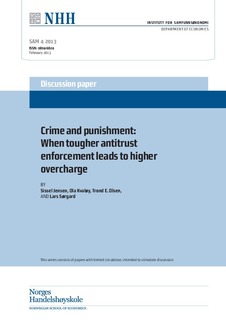| dc.contributor.author | Jensen, Sissel | |
| dc.contributor.author | Kvaløy, Ola | |
| dc.contributor.author | Olsen, Trond E. | |
| dc.contributor.author | Sørgard, Lars | |
| dc.date.accessioned | 2013-03-14T12:16:25Z | |
| dc.date.available | 2013-03-14T12:16:25Z | |
| dc.date.issued | 2013-02 | |
| dc.identifier.issn | 0804-6824 | |
| dc.identifier.uri | http://hdl.handle.net/11250/163336 | |
| dc.description.abstract | The economics of crime and punishment postulates that higher
punishment leads to lower crime levels, or less severe crime. It is
however hard to get empirical support for this intuitive relationship.
This paper offers a model that contributes to explain why this is the
case. We show that if criminals can spend resources to reduce the
probability of being detected, then a higher general punishment level
can increase the crime level. In the context of antitrust enforcement, it
is shown that competition authorities who attempt to ght cartels by
means of tougher sanctions for all offenders may actually lead cartels
to increase their overcharge when leniency programs are in place. | no_NO |
| dc.language.iso | eng | no_NO |
| dc.publisher | Norwegian School of Economics, Department of Economics | no_NO |
| dc.relation.ispartofseries | Discussion paper;4/2013 | |
| dc.subject | antitrust enforcement | no_NO |
| dc.subject | leniency programs | no_NO |
| dc.subject | economics of crime | no_NO |
| dc.title | Crime and punishment : when tougher antitrust enforcement leads to higher overcharge | no_NO |
| dc.type | Working paper | no_NO |
| dc.subject.nsi | VDP::Social science: 200::Economics: 210::Economics: 212 | no_NO |
